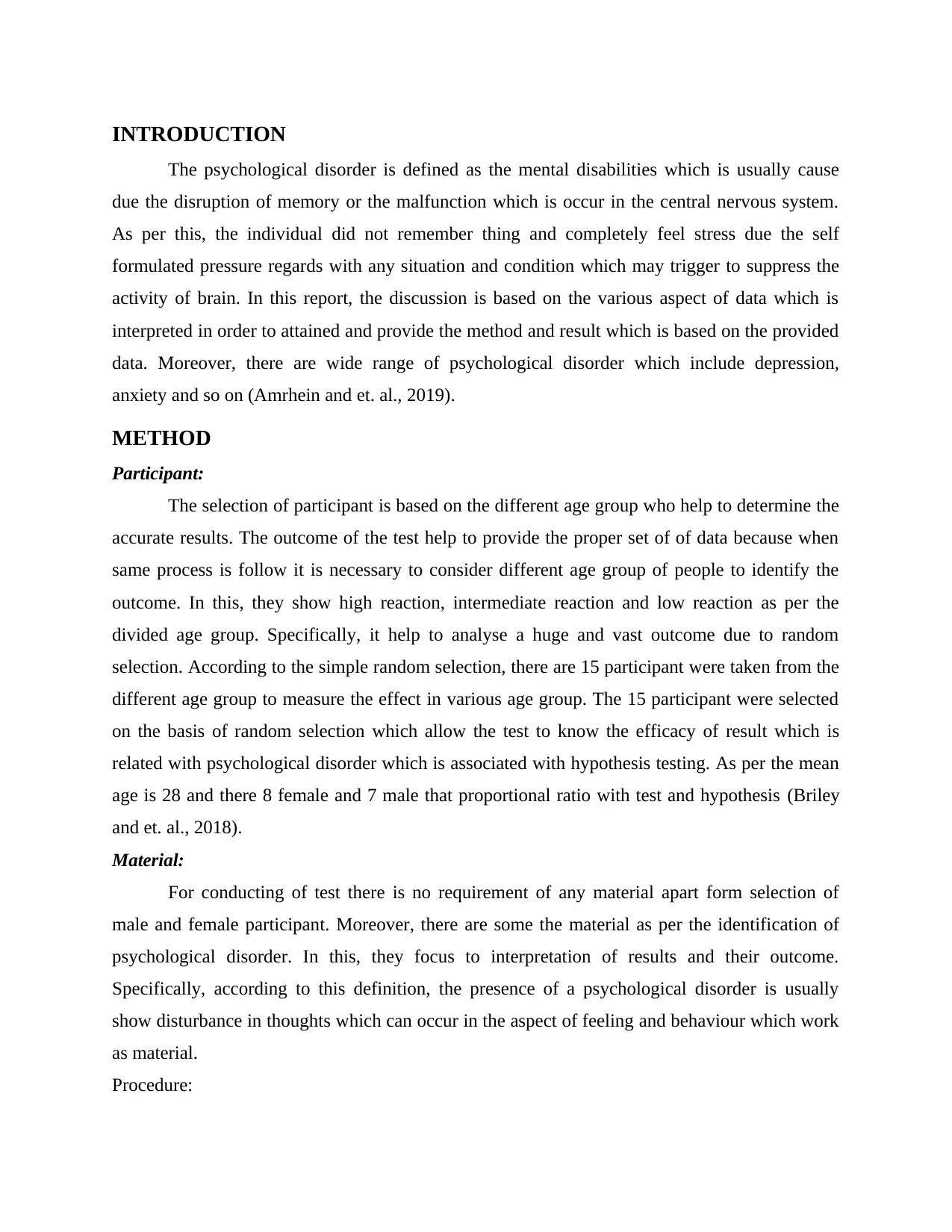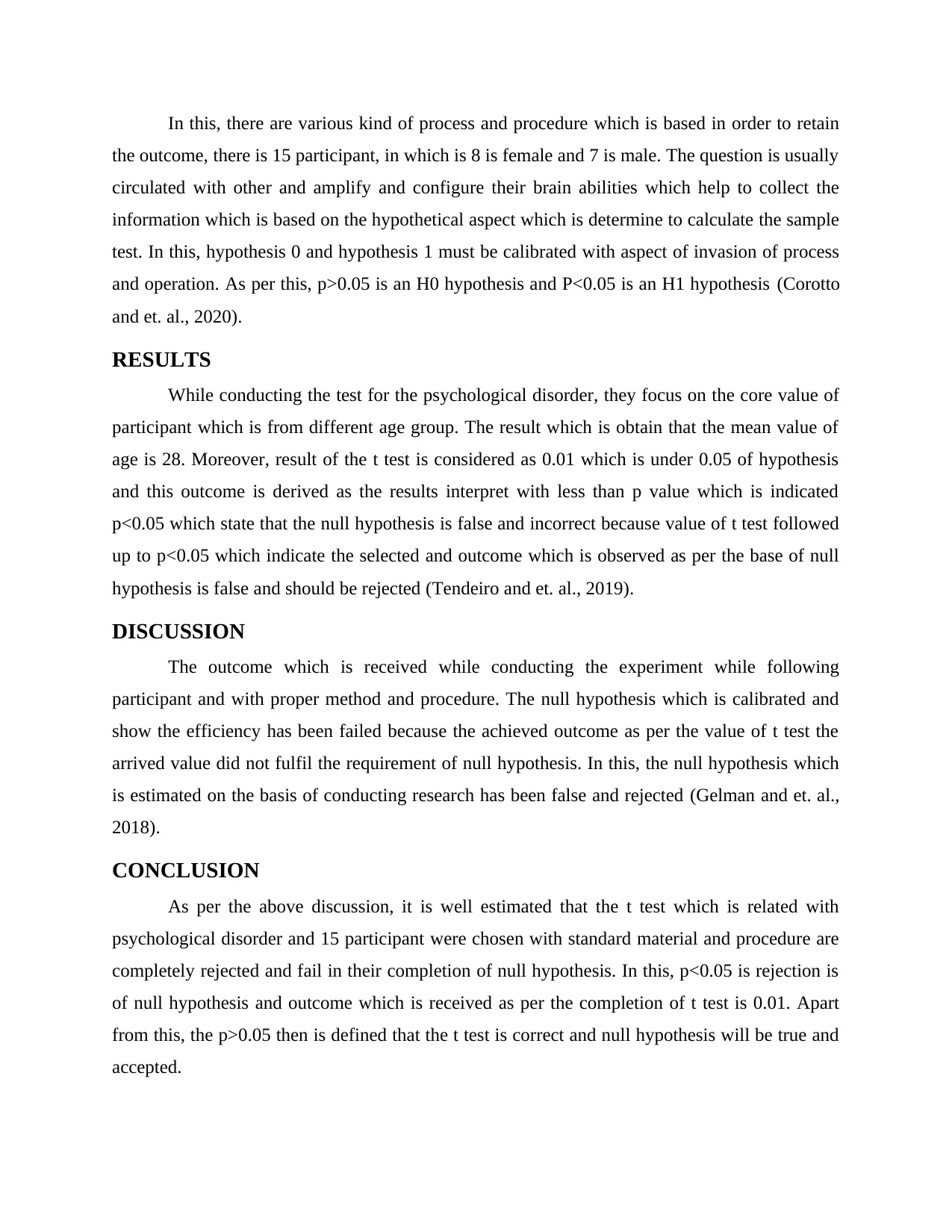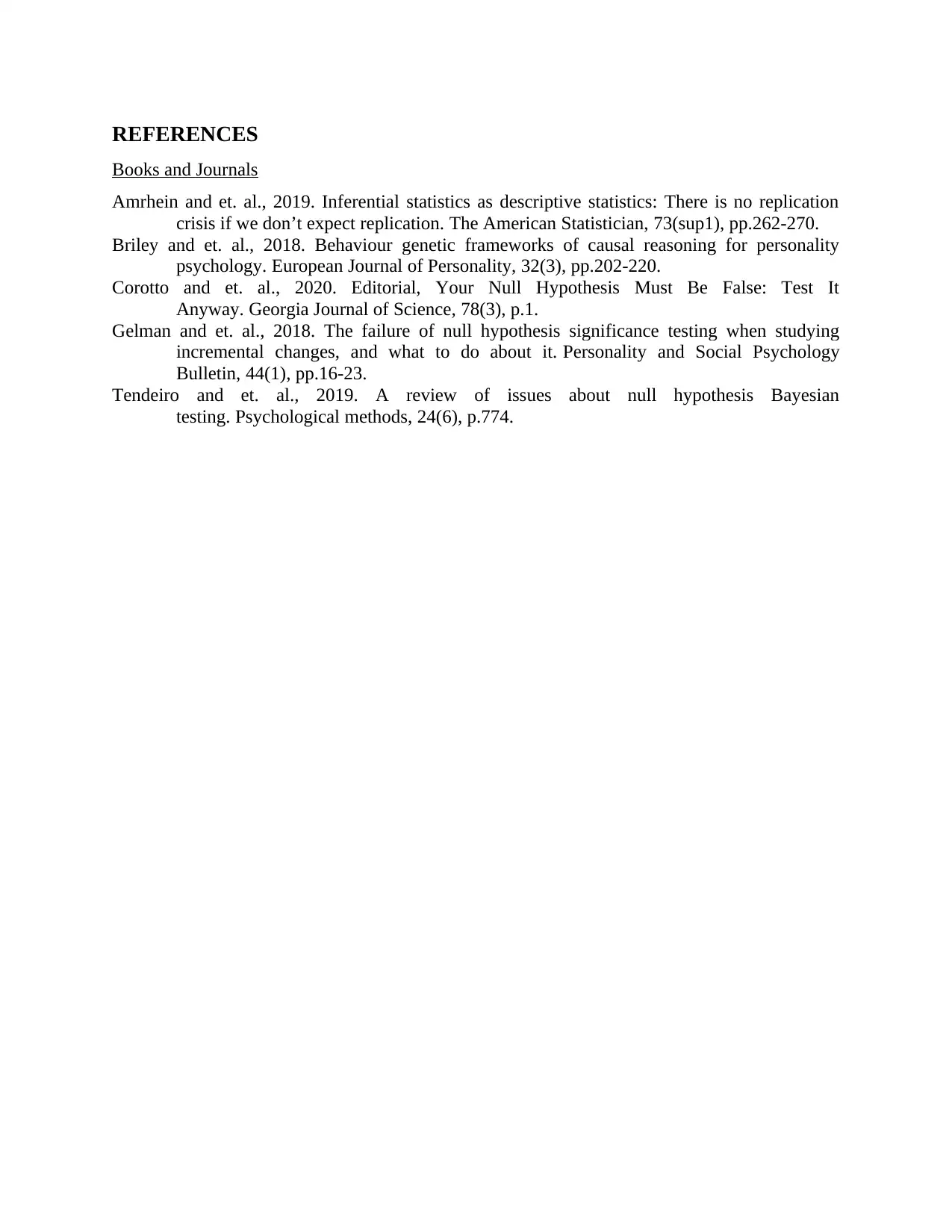Report on Anxiety: Psychological Disorder Analysis with T-Test
VerifiedAdded on 2023/06/18
|5
|1027
|391
Report
AI Summary
This report investigates anxiety as a psychological disorder, employing a t-test analysis on data collected from 15 participants across different age groups. The methodology involved random selection of participants and focused on interpreting results related to disturbances in thoughts, feelings, and behavior. The study tested a null hypothesis (p>0.05) against an alternative hypothesis (p<0.05). The results indicated a t-test value of 0.01, leading to the rejection of the null hypothesis, suggesting a significant correlation. The discussion emphasizes the failure of the null hypothesis, concluding that the initial hypothesis was incorrect based on the achieved t-test value. This report provides insights into the application of statistical methods in psychological research and the analysis of anxiety disorders. Desklib provides access to similar solved assignments and study resources for students.

ANXIETY
Paraphrase This Document
Need a fresh take? Get an instant paraphrase of this document with our AI Paraphraser

Table of Contents
INTRODUCTION ..........................................................................................................................3
METHOD........................................................................................................................................3
RESULTS .......................................................................................................................................4
DISCUSSION .................................................................................................................................4
CONCLUSION................................................................................................................................4
REFERENCES................................................................................................................................5
INTRODUCTION ..........................................................................................................................3
METHOD........................................................................................................................................3
RESULTS .......................................................................................................................................4
DISCUSSION .................................................................................................................................4
CONCLUSION................................................................................................................................4
REFERENCES................................................................................................................................5

INTRODUCTION
The psychological disorder is defined as the mental disabilities which is usually cause
due the disruption of memory or the malfunction which is occur in the central nervous system.
As per this, the individual did not remember thing and completely feel stress due the self
formulated pressure regards with any situation and condition which may trigger to suppress the
activity of brain. In this report, the discussion is based on the various aspect of data which is
interpreted in order to attained and provide the method and result which is based on the provided
data. Moreover, there are wide range of psychological disorder which include depression,
anxiety and so on (Amrhein and et. al., 2019).
METHOD
Participant:
The selection of participant is based on the different age group who help to determine the
accurate results. The outcome of the test help to provide the proper set of of data because when
same process is follow it is necessary to consider different age group of people to identify the
outcome. In this, they show high reaction, intermediate reaction and low reaction as per the
divided age group. Specifically, it help to analyse a huge and vast outcome due to random
selection. According to the simple random selection, there are 15 participant were taken from the
different age group to measure the effect in various age group. The 15 participant were selected
on the basis of random selection which allow the test to know the efficacy of result which is
related with psychological disorder which is associated with hypothesis testing. As per the mean
age is 28 and there 8 female and 7 male that proportional ratio with test and hypothesis (Briley
and et. al., 2018).
Material:
For conducting of test there is no requirement of any material apart form selection of
male and female participant. Moreover, there are some the material as per the identification of
psychological disorder. In this, they focus to interpretation of results and their outcome.
Specifically, according to this definition, the presence of a psychological disorder is usually
show disturbance in thoughts which can occur in the aspect of feeling and behaviour which work
as material.
Procedure:
The psychological disorder is defined as the mental disabilities which is usually cause
due the disruption of memory or the malfunction which is occur in the central nervous system.
As per this, the individual did not remember thing and completely feel stress due the self
formulated pressure regards with any situation and condition which may trigger to suppress the
activity of brain. In this report, the discussion is based on the various aspect of data which is
interpreted in order to attained and provide the method and result which is based on the provided
data. Moreover, there are wide range of psychological disorder which include depression,
anxiety and so on (Amrhein and et. al., 2019).
METHOD
Participant:
The selection of participant is based on the different age group who help to determine the
accurate results. The outcome of the test help to provide the proper set of of data because when
same process is follow it is necessary to consider different age group of people to identify the
outcome. In this, they show high reaction, intermediate reaction and low reaction as per the
divided age group. Specifically, it help to analyse a huge and vast outcome due to random
selection. According to the simple random selection, there are 15 participant were taken from the
different age group to measure the effect in various age group. The 15 participant were selected
on the basis of random selection which allow the test to know the efficacy of result which is
related with psychological disorder which is associated with hypothesis testing. As per the mean
age is 28 and there 8 female and 7 male that proportional ratio with test and hypothesis (Briley
and et. al., 2018).
Material:
For conducting of test there is no requirement of any material apart form selection of
male and female participant. Moreover, there are some the material as per the identification of
psychological disorder. In this, they focus to interpretation of results and their outcome.
Specifically, according to this definition, the presence of a psychological disorder is usually
show disturbance in thoughts which can occur in the aspect of feeling and behaviour which work
as material.
Procedure:
⊘ This is a preview!⊘
Do you want full access?
Subscribe today to unlock all pages.

Trusted by 1+ million students worldwide

In this, there are various kind of process and procedure which is based in order to retain
the outcome, there is 15 participant, in which is 8 is female and 7 is male. The question is usually
circulated with other and amplify and configure their brain abilities which help to collect the
information which is based on the hypothetical aspect which is determine to calculate the sample
test. In this, hypothesis 0 and hypothesis 1 must be calibrated with aspect of invasion of process
and operation. As per this, p>0.05 is an H0 hypothesis and P<0.05 is an H1 hypothesis (Corotto
and et. al., 2020).
RESULTS
While conducting the test for the psychological disorder, they focus on the core value of
participant which is from different age group. The result which is obtain that the mean value of
age is 28. Moreover, result of the t test is considered as 0.01 which is under 0.05 of hypothesis
and this outcome is derived as the results interpret with less than p value which is indicated
p<0.05 which state that the null hypothesis is false and incorrect because value of t test followed
up to p<0.05 which indicate the selected and outcome which is observed as per the base of null
hypothesis is false and should be rejected (Tendeiro and et. al., 2019).
DISCUSSION
The outcome which is received while conducting the experiment while following
participant and with proper method and procedure. The null hypothesis which is calibrated and
show the efficiency has been failed because the achieved outcome as per the value of t test the
arrived value did not fulfil the requirement of null hypothesis. In this, the null hypothesis which
is estimated on the basis of conducting research has been false and rejected (Gelman and et. al.,
2018).
CONCLUSION
As per the above discussion, it is well estimated that the t test which is related with
psychological disorder and 15 participant were chosen with standard material and procedure are
completely rejected and fail in their completion of null hypothesis. In this, p<0.05 is rejection is
of null hypothesis and outcome which is received as per the completion of t test is 0.01. Apart
from this, the p>0.05 then is defined that the t test is correct and null hypothesis will be true and
accepted.
the outcome, there is 15 participant, in which is 8 is female and 7 is male. The question is usually
circulated with other and amplify and configure their brain abilities which help to collect the
information which is based on the hypothetical aspect which is determine to calculate the sample
test. In this, hypothesis 0 and hypothesis 1 must be calibrated with aspect of invasion of process
and operation. As per this, p>0.05 is an H0 hypothesis and P<0.05 is an H1 hypothesis (Corotto
and et. al., 2020).
RESULTS
While conducting the test for the psychological disorder, they focus on the core value of
participant which is from different age group. The result which is obtain that the mean value of
age is 28. Moreover, result of the t test is considered as 0.01 which is under 0.05 of hypothesis
and this outcome is derived as the results interpret with less than p value which is indicated
p<0.05 which state that the null hypothesis is false and incorrect because value of t test followed
up to p<0.05 which indicate the selected and outcome which is observed as per the base of null
hypothesis is false and should be rejected (Tendeiro and et. al., 2019).
DISCUSSION
The outcome which is received while conducting the experiment while following
participant and with proper method and procedure. The null hypothesis which is calibrated and
show the efficiency has been failed because the achieved outcome as per the value of t test the
arrived value did not fulfil the requirement of null hypothesis. In this, the null hypothesis which
is estimated on the basis of conducting research has been false and rejected (Gelman and et. al.,
2018).
CONCLUSION
As per the above discussion, it is well estimated that the t test which is related with
psychological disorder and 15 participant were chosen with standard material and procedure are
completely rejected and fail in their completion of null hypothesis. In this, p<0.05 is rejection is
of null hypothesis and outcome which is received as per the completion of t test is 0.01. Apart
from this, the p>0.05 then is defined that the t test is correct and null hypothesis will be true and
accepted.
Paraphrase This Document
Need a fresh take? Get an instant paraphrase of this document with our AI Paraphraser

REFERENCES
Books and Journals
Amrhein and et. al., 2019. Inferential statistics as descriptive statistics: There is no replication
crisis if we don’t expect replication. The American Statistician, 73(sup1), pp.262-270.
Briley and et. al., 2018. Behaviour genetic frameworks of causal reasoning for personality
psychology. European Journal of Personality, 32(3), pp.202-220.
Corotto and et. al., 2020. Editorial, Your Null Hypothesis Must Be False: Test It
Anyway. Georgia Journal of Science, 78(3), p.1.
Gelman and et. al., 2018. The failure of null hypothesis significance testing when studying
incremental changes, and what to do about it. Personality and Social Psychology
Bulletin, 44(1), pp.16-23.
Tendeiro and et. al., 2019. A review of issues about null hypothesis Bayesian
testing. Psychological methods, 24(6), p.774.
Books and Journals
Amrhein and et. al., 2019. Inferential statistics as descriptive statistics: There is no replication
crisis if we don’t expect replication. The American Statistician, 73(sup1), pp.262-270.
Briley and et. al., 2018. Behaviour genetic frameworks of causal reasoning for personality
psychology. European Journal of Personality, 32(3), pp.202-220.
Corotto and et. al., 2020. Editorial, Your Null Hypothesis Must Be False: Test It
Anyway. Georgia Journal of Science, 78(3), p.1.
Gelman and et. al., 2018. The failure of null hypothesis significance testing when studying
incremental changes, and what to do about it. Personality and Social Psychology
Bulletin, 44(1), pp.16-23.
Tendeiro and et. al., 2019. A review of issues about null hypothesis Bayesian
testing. Psychological methods, 24(6), p.774.
1 out of 5
Related Documents
Your All-in-One AI-Powered Toolkit for Academic Success.
+13062052269
info@desklib.com
Available 24*7 on WhatsApp / Email
![[object Object]](/_next/static/media/star-bottom.7253800d.svg)
Unlock your academic potential
Copyright © 2020–2025 A2Z Services. All Rights Reserved. Developed and managed by ZUCOL.





